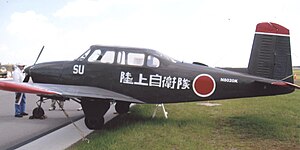Fuji LM-1 Nikko
| LM-1 Nikko | |
|---|---|
 |
|
| Airworthy Fuji LM-1 Nikko of 1955 in JGSDF markings at Lakeland, Florida, in April 2009 | |
| Role | military communications aircraft |
| National origin | Japan |
| Manufacturer | Fuji Heavy Industries |
| First flight | 6 June 1955 |
| Introduction | 1955 |
| Primary user | Japanese Air Self-Defense Force |
| Number built | 27 |
| Developed from | Beech T-34 Mentor |
| Variants |
Fuji KM-2 RTAF-2 |
The Fuji LM-1 Nikko is a Japanese light communications aircraft of the 1950s.
Fuji Heavy Industries built 176 Beech T-34 Mentor two-seat training aircraft under licence in the early 1950s. Fuji then redesigned the basic Mentor as a four-seat communications aircraft under the designation LM-1. A new lengthened centre fuselage was added to the Mentor's wing, undercarriage and tail assembly. 27 LM-1s were produced during 1955/56.
The LM-1s were delivered to the Japanese Air Self-Defense Force (JASDF) and were used for communications and general duties. After withdrawal from operation, several LM-1s were sold on the U.S. civil market and are flown by civil pilots as "warbirds".
LM-1: four-seat communications aircraft with 225 h.p. (168 kW) Continental engine (27 built)
LM-2: higher-powered version with 340 h.p. (254 kW) Lycoming engine (2 built)
RTAF-2: a variant developed in Thailand by Thai Aviation Industry.
Data from Green, 1956, p. 86
General characteristics
Performance
...
Wikipedia
